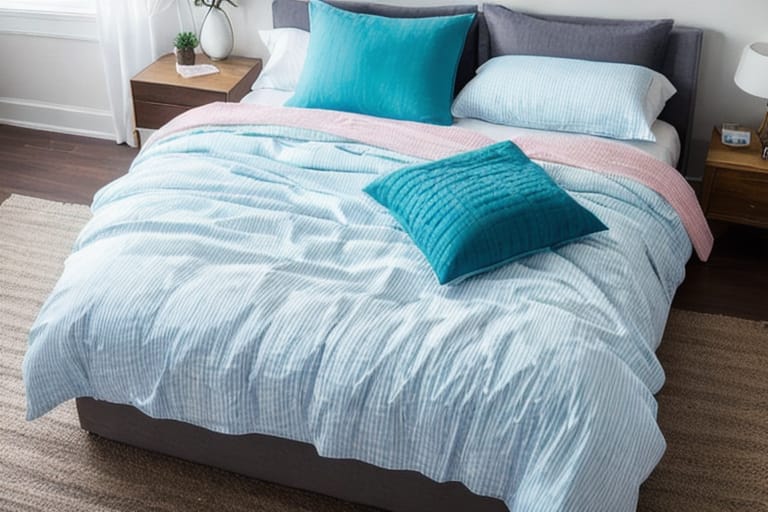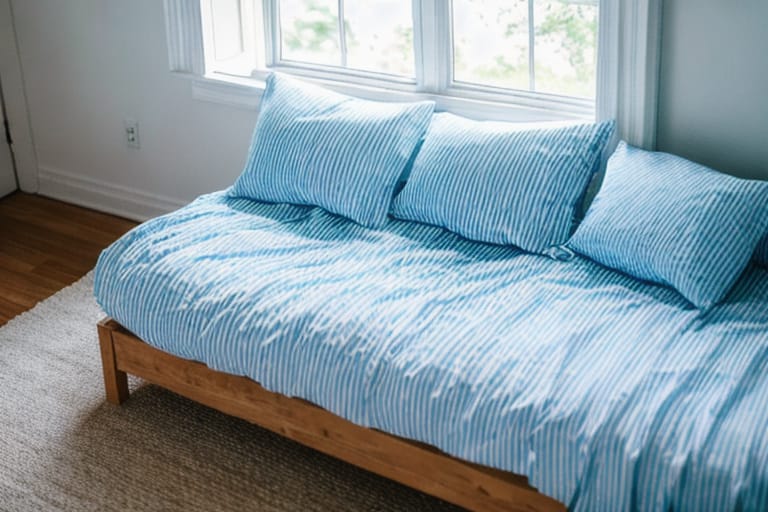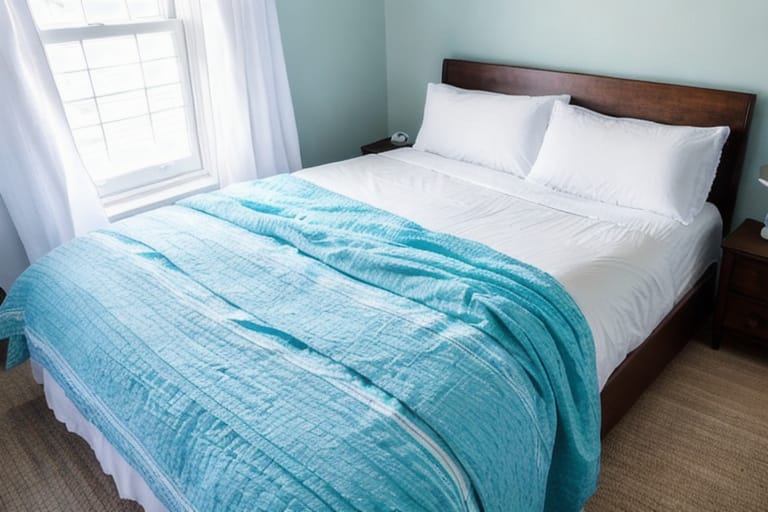When the summer sun is blazing and temperatures soar, lightweight, breathable bedding is key for sleeping cool and comfortable. But can a down-filled comforter cut when sweat and stickiness spell restless nights?
Surprisingly, the answer might be yes – with some caveats.
Down comforters have a reputation for unbeatable warmth and plush coziness. But modern down bedding offers innovative designs perfect for temperature regulation in warmer weather.
In this beginner’s guide, we’ll break down the pros and cons of down comforters for summer and provide tips for choosing the best lightweight, breathable down comforter for hot sleepers.
What Is a Down Comforter?
A down comforter is a type of duvet filled with fine, fluffy down clusters that grow beneath the feathers of ducks and geese. This soft natural insulation traps body heat, creating a barrier that keeps cold out and warmth in.
Unlike blankets or quilts, down comforters don’t have an underside or TOP side – the puffy fill is evenly distributed throughout slim baffle boxes that prevent shifting. A lightweight barrier fabric called a “cambric shell” contains the fill.
The Benefits of Down Comforters in Warmer Weather
Down comforters offer exceptional breathability compared to other insulation materials like wool or polyester. The fluffy, supple structure allows more airflow to cut down on sweat and stickiness.
For those who run hot but love to cuddle under a fluffy cloud of comfort, the right-down comforter strikes a perfect balance of gentle warmth and cool sleep.
Here are some of the reasons down can STILL excel – even in summer:
1. Superior Temperature Control
- The 3D structure formed by delicate down clusters facilitates excellent airflow and breathability. This allows your body heat to dissipate instead of getting trapped next to your skin.
- Higher fill power down between 600-900 cuin (cubic inches per ounce) has even more space between clusters for superior breathability. This leads to better temperature regulation in warm weather.
2. Moisture Wicking Properties
- Natural down has specialized cells that release extra moisture vapor to remain dry and lofty.
- When humidity is high, performance finishes like DOWNTEK enhance water resistance to keep Down’s insulating power intact. This prevents the bogged down feeling of clammy bedding.
3. Lightweight Designs
- Summer-specific down comforters have lightweight shells and low fill power for gentle warmth perfect for hot, humid nights.
- With less fill between you and the air, body heat dissipates instead of accumulating under sweltering bedding.
4. Luxurious Year-Round Comfort
- A lightweight down comforter offers that irresistible “sleeping on a cloud” feel without overheating.
- You can use a single down comforter as a plush top layer during cold weather and solo as a summer blanket once hotter temps hit.
Factors That Affect Down Comforter Performance in Summer
The optimal down comforter for summer strikes a fine balance. The insulation can’t be SO lightweight that there’s no cozy warmth, or SO heavy that you wake up in a sweaty tangle of bedding!
Here are key criteria that determine whether down bedding can keep hot sleepers cool:
1. Fill Power
[[Fill power chart showing range from light warmth to heavy]]
Fill power refers to volume – it’s the cubic inches occupied by one ounce (28g) of down. This correlates with warmth, fluffiness, and durability.
- Lower fill powers around 300-600 cuin are best for summer. Light, breathable comforters allow better airflow and heat dissipation.
- Higher fill powers above 700+ cuin trap MORE body heat. Great for frigid winter nights but TOO insulating for summer.
2. Fill Weight
A down comforter’s fill weight tells you the TOTAL ounces of down inside. Just like with power, lighter = cooler, and heavier = warmer.
10-15 oz is lightweight enough for summer warmth. Conversely, a brawny 30 oz fill weight comforter is suited for cold climates.
3. Shell Fabric
Along with power and weight, the outer shell fabric impacts airflow and temperature control:
- Cotton shells offer exceptional breathability.
- Sateen shells have a silky luster and lightweight structure.
- Percale shells are crisp, breathable, and durable.

Top 5 Summer-Specific Down Comforters
Here are our top picks for lightweight down comforters with stellar sweat-fighting powers:
| Product | Fill Power | Fill Weight | Shell Fabric | Price |
|---|---|---|---|---|
| Brooklinen Lightweight Down Comforter | 600 cuin | 15 oz | 400TC Cotton Sateen | $319+ |
| Buffy Cloud Comforter | New proprietary fill | Varies | Eucalyptus Tencel lyocell | $159+ |
| Parachute Lightweight Linen Down Duvet | 600-650 cuin | Corner Duvet | 100% Washed Linen | $349+ |
| COYY All Season Down Comforter | 550-600 cuin | 15 oz | 300 TC Cotton | $139+ |
| IKEA Hönsväd Down Filled Comforter | 600 cuin | 16 oz | 233 TC Percale | $179 |
What About Down Alternative Comforters?
Down alternative comforters use polyester, microfiber, or other synthetic fills instead of natural down. The materials are engineered for softness and mimic some down properties like fluffiness. But they fall short when it comes to:
❌ Trapping Heat:
- Synthetics are less breathable, causing body heat and moisture to accumulate.
❌ Temperature Regulation:
- Materials like polyester hold onto warmth instead of allowing it to dissipate.
❌ Longevity and Durability:
- Over time, alternative fills become lumpy instead of maintaining cloud-like loft.
While more budget-friendly, down alternative comforters pose higher risks for night sweats. If heat regulation is a priority, natural down is the best bet for staying cool.
Do You Need a Comforter in Summer At All?
In climates with cool nights dipping around 65°F or below, a lightweight down comforter can make sleeping more comfortable. The gentle weight and soft insulation guard against chilly breezes from air conditioning.
But in hot, humid environments where overheating is inevitable regardless of bedding, nixing a top cover entirely may be wisest.
Tips for Optimizing a Down Comforter for Summer Use
Take these steps to combat heat and humidity for peaceful, sweat-free summer slumber:
1. Supplement with Lighter Layers
- Use an open-weave cotton blanket or linen duvet cover over your comforter to allow maximum airflow.
- For ultra-warm climates, switch out the comforter for only these lighter layers.
2. Adjust Temperature at Night
- Bump A/C temps down to 65-68° at bedtime to support cooling.
- Crack windows or set ceiling fans to medium to facilitate airflow.
3. Clean Regularly
- Wash bedding weekly to eliminate sweat, oils, and allergens that can exacerbate heat.
- Dry clean down comforters every 6 months to restore loft and breathability.
4. Store Properly Off-Season
- During summer, place the comforter INSIDE a breathable cotton storage bag.
- Store flat (NOT compressed) in a cool, moisture-free environment.
Following these best practices goes a long way towards sleeping chill, even for those who run hot!
Are There Any Drawbacks to Using a Down Comforter in Summer?
While the right down comforter CAN keep you cozy yet cool in summer, a few cons need consideration:
❌ Higher Price Point
At $100-$500+, down comforters have a luxury price tag. Budget shoppers may prefer cheaper down alternative options.
❌ Special Cleaning Requirements
Frequent washing is a must in summer’s humidity. But take care to properly dry clean down comforters to preserve delicate materials.
❌ Feather Allergies
Watch out for pesky particles triggering reactions despite barrier fabrics. Allergy bedding covers add protective layers against irritants.

Ready for the Best Sleep of Your Life – No Matter the Season?
The bottom line – innovative down comforters NOW exist that cradle you in gentle warmth without overheating, even for sweat-prone hot sleepers.
Balmy summer nights call for breathable bedding that expertly regulates body temperature. From plush, moisture-wicking fills to airy outer shell fabrics, today’s lightweight down comforters check ALL the boxes.
Frequency Asked Questions
Still, have some questions about using down comforters when temperatures rise. Here are answers to some frequently asked questions:
Can I use a down comforter in the summer if I sleep hot?
Yes, IF you choose the right fill power and weight. The best down comforters for summer are lightweight with lower fill powers between 300-600 cuin. This allows for the superior breathability and airflow that hot sleepers need. Pair it with lightweight cotton or linen covers for maximum temperature regulation.
What’s better for summer – down or down alternative comforters?
Down is more breathable and better at moisture-wicking than synthetic downs. Materials like polyester trap heat instead of letting it dissipate. However, down alternatives can be cheaper if you’re on a budget.
Should I use a lightweight down comforter with a duvet cover in the summer?
Yes, a lightweight duvet cover made of a breathable fabric like linen or cotton is ideal. The duvet protects the down while letting air circulate. For super hot nights, use just the cover instead of the comforter.
How often should I clean my down comforter in summer?
Launder your down comforter at LEAST once per month in the summer. Frequent washing prevents sweat, body oils, and allergens from accumulating. Be sure to properly dry clean down comforters to avoid damage.
What’s the best way to store a down comforter in summer?
In humid summer months, always store comforters flat in breathable cotton storage bags rather than compressing them tightly. Allowing the loft to rebound fully revitalizes insulation power and extends the lifespan.








